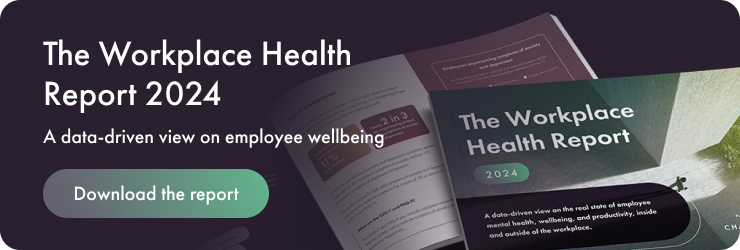One of the biggest questions we are constantly asked by people leaders is how to get business buy-in for wellbeing. But what about when you quite simply don’t have buy-in, particularly at board level? Employee wellbeing without board buy-in can seem like a difficult feat to overcome.
It’s a hurdle that can stop wellbeing strategies right in their tracks. Not to mention how demoralising it can be for those trying to spearhead wellbeing within their organisation.
But fear not. Just because your board isn’t sold, doesn’t mean you are stuck. There are ways to not only implement employee wellbeing without board buy-in but to also prove its worth.
Here’s how.
Start small, think quick
Begin with smaller, low-cost and high-impact initiatives that can demonstrate results and deliver quick wins:
-
- Gather intel: Understand the mood of your people by kicking off with an employee survey that will allow them to tell you what they need from you.
- Be flexible: If you can, allow employees to work flexibly – whether that is working hours, schedule or location. Doing this can quickly reduce stress levels, improve work-life balance and increase productivity.
- Practice mindfulness: There are easy ways to do this from online workshops to hiring a practitioner to run in-person sessions. This can give employees the tools they need to manage their mental health.
- Reduce meetings: Try to limit the amount of time people are tied up in meetings. Empower them to take ownership of their time, give them the space to focus on their work and recharge when needed.
Remember that everything you do should be well documented and analysed so that you can share findings, suggestions, and successes from your initiatives. This is what will make your board sit up and listen.
It’s all about data
In business, data speaks louder than almost anything else. Once you have crucial insights from your employee survey, you can use that data to your advantage.
Metrics around absenteeism rates, productivity levels, and employee turnover provide a compelling narrative about the need for wellbeing initiatives.
But don’t let it be a one-and-done exercise. Continue to ask your employees for feedback at least once a quarter (so that you have time to see the impact of your work). Allow them to remain anonymous so you can get their honest – even brutal – thoughts. Only then can you understand the true state of employee wellbeing within your business.
As you use this data to inform wellbeing ideas and activities, ensure you are measuring it against business goals. Presenting this to the board can help them see the direct connection between wellbeing and the company’s bottom line (more on this later).
Recruit wellbeing champions
Change often comes from within, and there is a way you can influence this change. Find champions who will actively advocate for employee wellbeing.
From experience, these people are usually incredibly passionate and want to do their bit to get everyone else on board. They can be line managers, department leaders or even board members who do believe in the importance of wellbeing.
Train these advocates on your initiatives, encourage them to market the benefits of wellbeing internally and reward them for their support.
If your champions can bring the rest of the business along with them, then there is no reason they cannot also sway sceptical board members.
Wellbeing and business goals as one
We mentioned business goals once, and we will mention it again. If you can align wellbeing goals to the overarching business strategy, then you can demonstrate how important it truly is.
Doing this can paint a pretty picture: improving employee wellbeing can lead to enhanced performance, loyalty, productivity, and creativity and, ultimately, boost customer satisfaction to new levels.
Happy employees = happy customers.
How wellbeing is positioned can also change mindsets. Rather than it being a standalone initiative that sits as a separate entity from everything else within an organisation, position it as a key driver of business success – that will turn heads.
And you don’t even need your own data to demonstrate wellbeing as a driver of success. Simply show the impact it has had on other organisations.
Sharing success stories and case studies from other companies that have integrated wellbeing into their business strategies can be even more influential than internal voices to board members.
By framing wellbeing in a business context, you instantly make it more relatable to your board.
Leverage external champions
As with sharing the successes of other businesses, sometimes validation from external experts can provide the confidence needed to gain internal support.
Take the time to identify wellbeing experts, influencers or organisations that specialise in employee health and wellness. Pick the people whose voices are heard and respected in the industry. Voices with the ability to shift mindsets and convert the non-believers.
You can bring these experts in to run workshops that underscore the importance of wellbeing, deliver training to leaders and managers, or even just get everyone excited about wellbeing.
Remember you can always look beyond people and take it back to the data instead. Use industry reports and benchmarks to show where your company stands in comparison to competitors regarding employee wellbeing.
While measuring up to competitors should not be the motivating factor behind endorsing wellbeing initiatives, it is a good indicator of where the market thinks organisations should be.
By leveraging these external insights, you can lend credibility to your vision and demonstrate the clear value of investing in wellbeing.
Communicate, always
We all know that communication can make or break nearly everything in life. But this is especially true for businesses. If you are not effective, regular and transparent in your communications with your colleagues then you will struggle to win their buy-in.
And when it comes to your board, you need these communications to share progress, setbacks, successes and learnings from wellbeing activities. If you are reporting on your initiatives, then you are demonstrating their impact.
With these lines of communication comes open dialogue. Build an open culture so all your colleagues – board included – can continue to provide that honest feedback we mentioned earlier. Only then will you know if what you are doing is working and what needs to change.
Wrapping things up
We won’t lie to you, implementing employee wellbeing without board buy-in will be challenging. And it’s not the ideal environment for wellbeing to thrive. Realistically, you need your leaders to embrace and prioritise wellbeing for your people to embrace and prioritise it.
If your leaders don’t adopt, the risk is your employees won’t either.
But that doesn’t mean it is impossible to be successful without that buy-in from the top.
By starting small, focusing on data, finding your internal and external champions and demonstrating the unequivocal impact of employee wellbeing on business success, you’ll be able to change minds in no time.
And if you want to tie all of this together into one, holistic wellbeing offering, that’s where Champion Health comes in.





